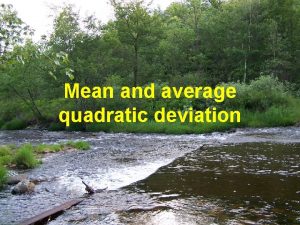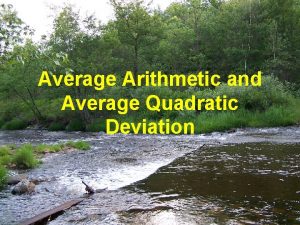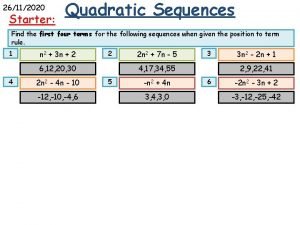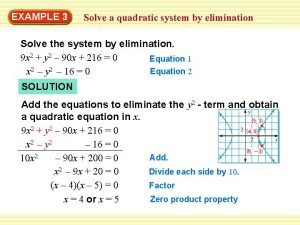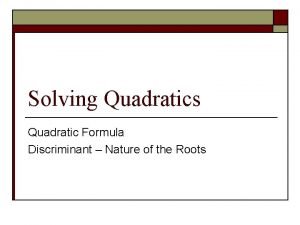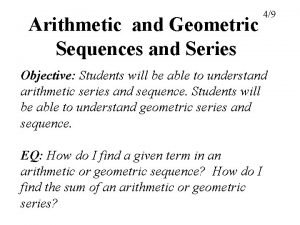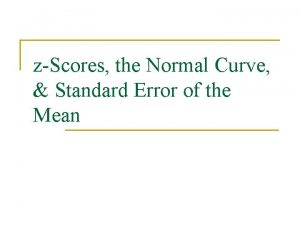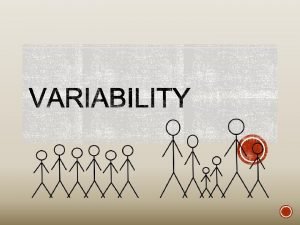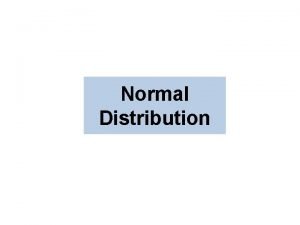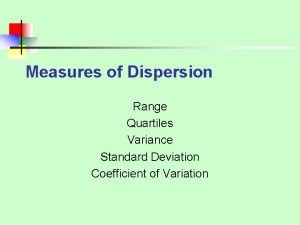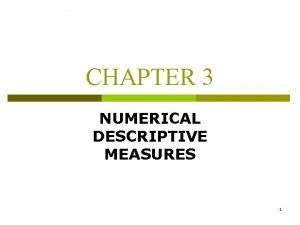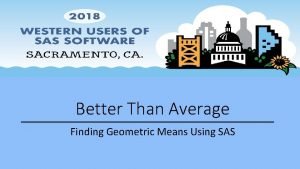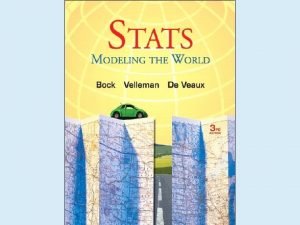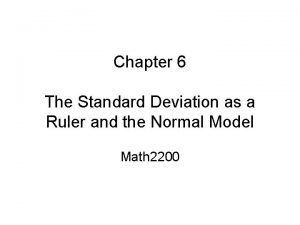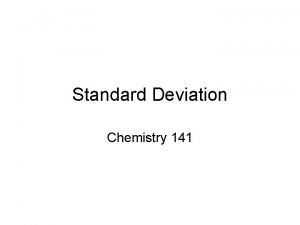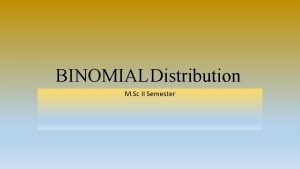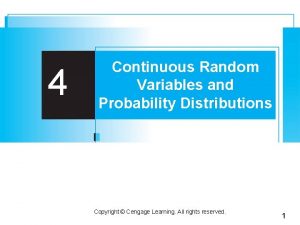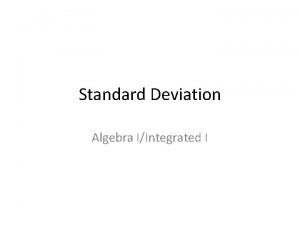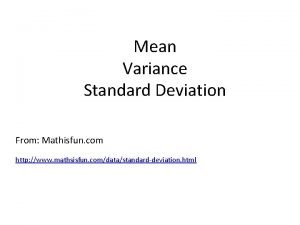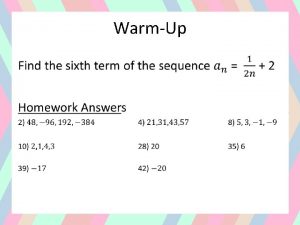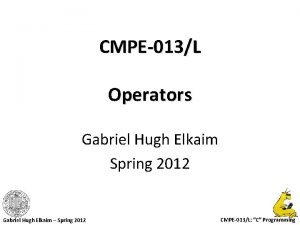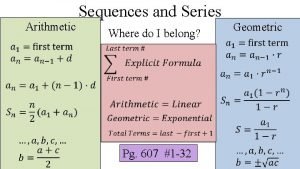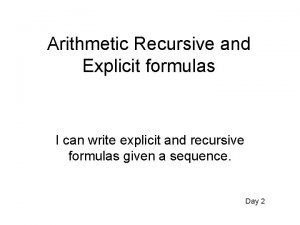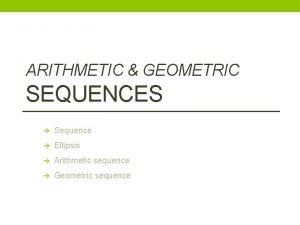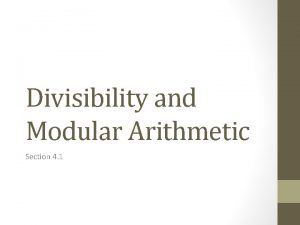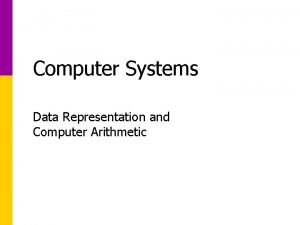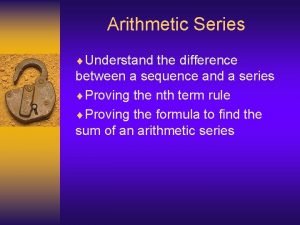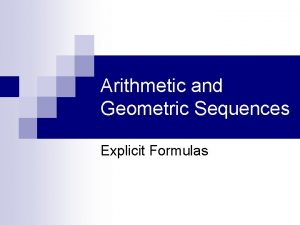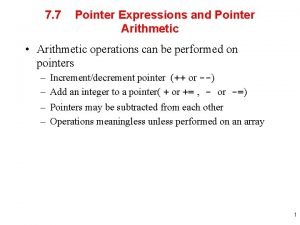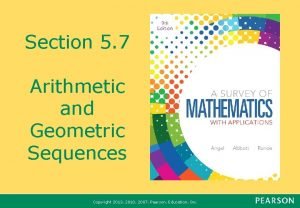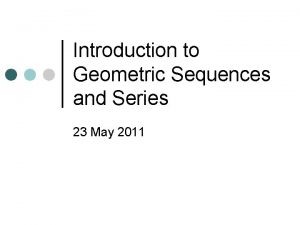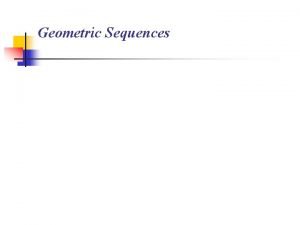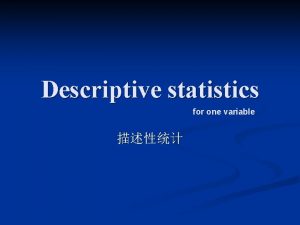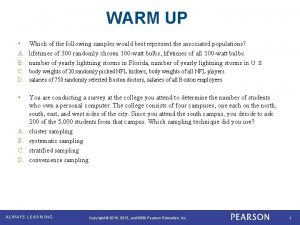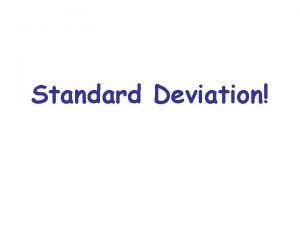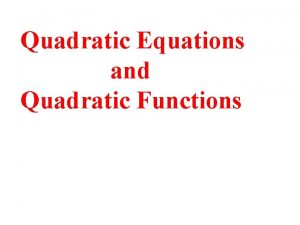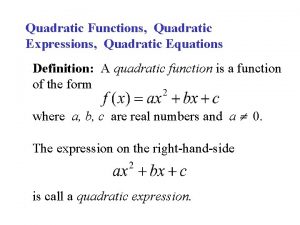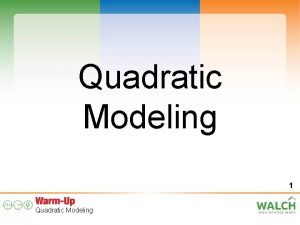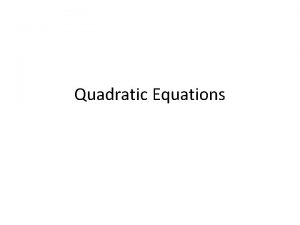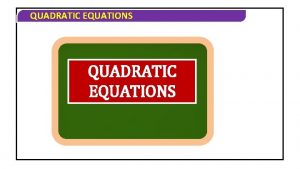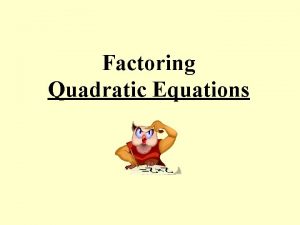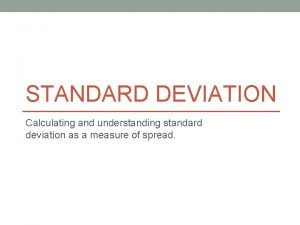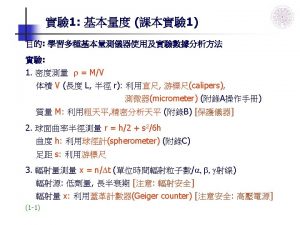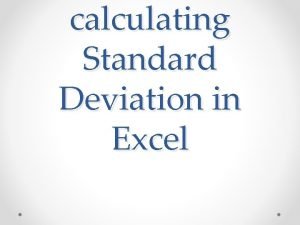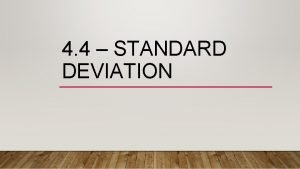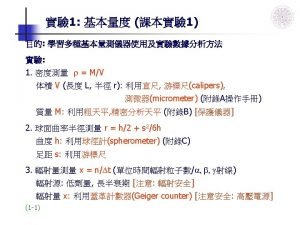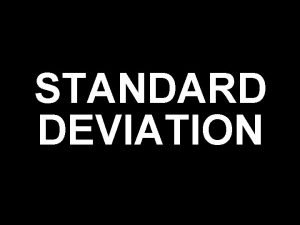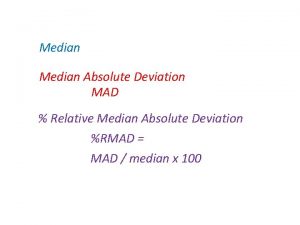Average Arithmetic and Average Quadratic Deviation Average Arithmetic































































- Slides: 63

Average Arithmetic and Average Quadratic Deviation

Average Arithmetic and Average Quadratic Deviation n The average values, which give the generalized quantitative description of certain characteristic in statistical totality at the certain terms of place and time, are the most widespread form of statistical indices. They represent the typical lines of variation characteristic of the explored phenomena.

Average Arithmetic and Average Quadratic Deviation n Because of that quantitative description of characteristic is related to its high-quality side, it follows to examine average values only in light of terms of high-quality analysis. Except of summarizing estimation of certain characteristic the necessity of determination of changeable quantitative average values for the totality arises up also, when two groups which high-quality differ one from other are compared.

The use of averages in health protection n for description of work organization of health protection establishments (middle employment of bed, term of stay in permanent establishment, amount of visits on one habitant and other);


The use of averages in health protection n for description of work organization of health protection establishments (middle employment of bed, term of stay in permanent establishment, amount of visits on one habitant and other);



The use of averages in health protection n for description of indices of physical development (length, mass of body, circumference of head of new-born and other);


Introduction n The purpose of HYPOTHESIS TESTING is to aid the clinician, researcher, or administrator in reaching a conclusion concerning a POPULATION by examining a SAMPLE from that population sample inference

inference parameter statistics sample

Hypothesis is…. A statement about one or more populations. e. g. n The average length of stay of patients admitted to the hospital is 5 days; n A certain drug will be effective in 90 percent of the cases for which it is used.

Estimation: approximate a characteristic of the population with a statistic computed from the sample m = population mean x = sample mean x is our estimate of m


Types of hypotheses n n Research hypothesis The research hypothesis is the conjecture or supposition that motivates the research. Statistical hypothesis Statistical hypotheses are hypotheses that are stated in such a way that they be evaluated by appropriate statistical techniques.

Example Twenty patients with a certain disease were randomly selected. The mean of enythrocyte sedimentation (ES) is 9. 15 with standard deviation of 2. 13. However, references reported mean of ES of this type of patients is 10. 50. n Question: Does the mean of ES of this sample differ from 10. 50? n


Types of errors Condition of null hypothesis Possible action P>0. 05 P<0. 05 Fail to reject H 0 Reject H 0 True False Correct action Type II error β Type I error α Correct action

Type I and II error (one tailed) H 0: μ=0 α 1 -α μ H 1: μ=μ 0>0 β μ 1 -β Uα (critical value) μ+δ

Decision making α/2=0. 025 Rejectio -1. 96 Non rejection 0 region 1. 96 n region

The use of averages in health protection n for description of indices of physical development (length, mass of body, circumference of head of new-born and other);

The use of averages in health protection n for determination of medical-physiology indices of organism (frequency of pulse, breathing, level of arterial pressure and other);

The use of averages in health protection n for estimation of these medical-social and sanitary-hygienic researches (middle number of laboratory researches, middle norms of food ration, level of radiation contamination and others).

Averages n Averages are widely used for comparison in time, that allows to characterize the major conformities to the law of development of the phenomenon. So, for example, conformity to the law of growth increase of certain age children finds the expression in the generalized indices of physical development. Conformities to the law of dynamics (increase or diminishment) of pulse rate, breathing, clinical parameters at the certain diseases find the display in statistical indices which represent the physiology parameters of organism and other.

Chi-square distribution 3. 84

Distribution rule To reject the H 0 if the value of the test statistic that we compute from our sample is one of the values in the rejection region ; To not reject the H 0 if the computed value of the test statistic is one of the values in the non-rejection region.

Significance level The decision as to which values go into the rejection region and which ones go into the non-rejection region is made on the basis of the desired level of significance, designated by α; The test statistic that falls in the rejection region is said to be significant.

Hypothesis testing steps 1. 2. 3. 4. 5. Data ----the nature of data ---test methods Assumption ---e. g. normality of population distribution, equality of variance, and independence of samples-makes it possible to use certain mathematic models to reach an estimation of the sample. Statistical Hypothesis and αlevel Statistic computation Decision making

Hypothesis The NULL HYPOTHESIS (H 0) is the hypothesis to be tested----hypothesis of no difference between mean of sample and mean of population n The ALTERNATIVE HYPOTHESIS (H 1) is a statement of what we will believe is true if our sample data cause us to reject the null hypothesis.

Test statistic Decision maker (reject or not to reject the H 0) n Computed from the data of the sample. n Compare the computed statistics from our sample to the corresponding CRITICAL VALUE, make decision n

General Formula for Test Statistic Test statistic =

Distribution of test statistic Sample distribution is the key to statistical inference. t distribution or standard normal distribution n For example; S t= n Follows the standard normal distribution if the hypothesis is true and the assumptions are met.

t distribution and u distribution

Decision making α/2=0. 025 Rejectio -1. 96 Non rejection 0 region 1. 96 n region

Chi-square distribution 3. 84

Type I and II error (one tailed) H 0: μ=0 α 1 -α μ H 1: μ=μ 0>0 β μ 1 -β Uα (critical value) μ+δ

Average Values n n n n Mean: the average of the data sensitive to outlying data Median: the middle of the data not sensitive to outlying data Mode: most commonly occurring value Range: the difference between the largest observation and the smallest Interquartile range: the spread of the data commonly used for skewed data Standard deviation: a single number which measures how much the observations vary around the mean Symmetrical data: data that follows normal distribution (mean=median=mode) report mean & standard deviation & n Skewed data: not normally distributed (mean median mode) report median & IQ Range

Average Values n Limit is the meaning of edge variant in a variation row lim = Vmin Vmax

Average Values n Amplitude is the difference of edge variant of variation row Am = Vmax - Vmin

Average Values n Average quadratic deviation characterizes dispersion of the variants around an ordinary value (inside structure of totalities).

Average quadratic deviation σ= simple arithmetical method

Average quadratic deviation d=V-M genuine declination of variants from the true middle arithmetic

Average quadratic deviation σ=i method of moments

Average quadratic deviation is needed for: 1. Estimations of typicalness of the middle arithmetic (М is typical for this row, if σ is less than 1/3 of average) value. 2. Getting the error of average value. 3. Determination of average norm of the phenomenon, which is studied (М± 1σ), sub norm (М± 2σ) and edge deviations (М± 3σ). 4. For construction of sigmal net at the estimation of physical development of an individual.

Average quadratic deviation This dispersion a variant around of average characterizes an average quadratic deviation ( )

n Coefficient of variation is the relative measure of variety; it is a percent correlation of standard deviation and arithmetic average.

Terms Used To Describe The Quality Of Measurements Reliability is variability between subjects divided by inter-subject variability plus measurement error. n Validity refers to the extent to which a test or surrogate is measuring what we think it is measuring. n

Measures Of Diagnostic Test Accuracy n n Sensitivity is defined as the ability of the test to identify correctly those who have the disease. Specificity is defined as the ability of the test to identify correctly those who do not have the disease. Predictive values are important for assessing how useful a test will be in the clinical setting at the individual patient level. The positive predictive value is the probability of disease in a patient with a positive test. Conversely, the negative predictive value is the probability that the patient does not have disease if he has a negative test result. Likelihood ratio indicates how much a given diagnostic test result will raise or lower the odds of having a disease relative to the prior probability of disease.

Measures Of Diagnostic Test Accuracy

Expressions Used When Making Inferences About Data n Confidence Intervals - The results of any study sample are an estimate of the true value in the entire population. The true value may actually be greater or less than what is observed. n n n Type I error (alpha) is the probability of incorrectly concluding there is a statistically significant difference in the population when none exists. Type II error (beta) is the probability of incorrectly concluding that there is no statistically significant difference in a population when one exists. Power is a measure of the ability of a study to detect a true difference.

Multivariable Regression Methods n n Multiple linear regression is used when the outcome data is a continuous variable such as weight. For example, one could estimate the effect of a diet on weight after adjusting for the effect of confounders such as smoking status. Logistic regression is used when the outcome data is binary such as cure or no cure. Logistic regression can be used to estimate the effect of an exposure on a binary outcome after adjusting for confounders.

Survival Analysis n n Kaplan-Meier analysis measures the ratio of surviving subjects (or those without an event) divided by the total number of subjects at risk for the event. Every time a subject has an event, the ratio is recalculated. These ratios are then used to generate a curve to graphically depict the probability of survival. Cox proportional hazards analysis is similar to the logistic regression method described above with the added advantage that it accounts for time to a binary event in the outcome variable. Thus, one can account for variation in follow-up time among subjects.

Kaplan-Meier Survival Curves

Why Use Statistics?

Descriptive Statistics Identifies patterns in the data n Identifies outliers n Guides choice of statistical test n

Percentage of Specimens Testing Positive for RSV (respiratory syncytial virus)

Descriptive Statistics

Distribution of Course Grades

Describing the Data with Numbers Measures of Dispersion • • • RANGE STANDARD DEVIATION SKEWNESS

Measures of Dispersion • RANGE highest to lowest values STANDARD DEVIATION • how closely do values cluster around the mean value SKEWNESS • refers to symmetry of curve • • •

The Normal Distribution n n Mean = median = mode Skew is zero 68% of values fall between 1 SD 95% of values fall between 2 SDs Mean, Median, Mode . 1 2

 Calculate mean absolute deviation
Calculate mean absolute deviation Quadratic deviation
Quadratic deviation Quadratic deviation
Quadratic deviation Formula for quadratic sequence
Formula for quadratic sequence Formula of mode for grouped data
Formula of mode for grouped data Any deviation from the average or from the majority
Any deviation from the average or from the majority Quadratic quadratic systems examples
Quadratic quadratic systems examples What is discriminant in quadratic equation
What is discriminant in quadratic equation Motion in straight line
Motion in straight line Arithmetic and geometric sequences and series
Arithmetic and geometric sequences and series Error
Error Variance formula in standard deviation
Variance formula in standard deviation Standard error or standard deviation
Standard error or standard deviation Covariance and standard deviation
Covariance and standard deviation Range variance and standard deviation
Range variance and standard deviation Basic principles of stylistics
Basic principles of stylistics How to compute sd
How to compute sd Mean variance and standard deviation
Mean variance and standard deviation Variance and standard deviation formula
Variance and standard deviation formula Proc surveymeans geometric mean
Proc surveymeans geometric mean Defamiliarization
Defamiliarization Probable error
Probable error Standard deviation as a ruler and the normal model
Standard deviation as a ruler and the normal model Chapter 6 the standard deviation as a ruler
Chapter 6 the standard deviation as a ruler Sig figs for standard deviation
Sig figs for standard deviation Benzene and acetone deviation
Benzene and acetone deviation Merit and demerit of standard deviation
Merit and demerit of standard deviation Exponential distribution mean and standard deviation
Exponential distribution mean and standard deviation Mean and standard deviation
Mean and standard deviation Mathisfun com
Mathisfun com Modeling with quadratic functions
Modeling with quadratic functions Unit 10 sequences and series homework 1 answers
Unit 10 sequences and series homework 1 answers Mathematical treasure hunt questions with answers
Mathematical treasure hunt questions with answers Cap 221
Cap 221 10-2 practice arithmetic sequences and series
10-2 practice arithmetic sequences and series Computer arithmetic: algorithms and hardware designs
Computer arithmetic: algorithms and hardware designs Difference between arithmetic shift and logical shift
Difference between arithmetic shift and logical shift Explicit arithmetic formula
Explicit arithmetic formula Difference between arithmetic shift and logical shift
Difference between arithmetic shift and logical shift Difference between arithmetic shift and logical shift
Difference between arithmetic shift and logical shift Difference between arithmetic shift and logical shift
Difference between arithmetic shift and logical shift Geometric and arithmetic sequences formulas
Geometric and arithmetic sequences formulas Recursive formula
Recursive formula Geomtric formula
Geomtric formula How to tell if a sequence is arithmetic
How to tell if a sequence is arithmetic Formula of geometric sequence
Formula of geometric sequence Microprogramming example
Microprogramming example Divisibility and modular arithmetic
Divisibility and modular arithmetic Data representation and computer arithmetic
Data representation and computer arithmetic Difference between arithmetic series and sequence
Difference between arithmetic series and sequence Arithmetic and geometric formulas
Arithmetic and geometric formulas Pointer expressions and pointer arithmetic in c
Pointer expressions and pointer arithmetic in c Lesson 3: arithmetic and geometric sequences
Lesson 3: arithmetic and geometric sequences Modular arithmetic in cryptography and network security
Modular arithmetic in cryptography and network security Sum of arithmetic series
Sum of arithmetic series Sequence series formula
Sequence series formula Geometric and arithmetic sequences
Geometric and arithmetic sequences Un=u1rn-1
Un=u1rn-1 Sum formula for geometric sequence
Sum formula for geometric sequence Merits of arithmetic mean
Merits of arithmetic mean Geometric sequences
Geometric sequences What is quartile deviation formula
What is quartile deviation formula Standard deviation symbols
Standard deviation symbols Factorial button on calculator
Factorial button on calculator

